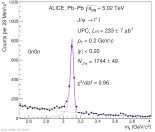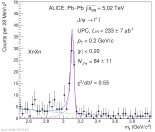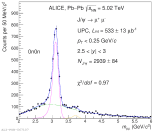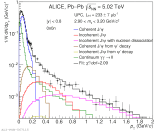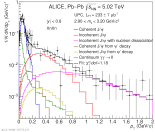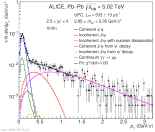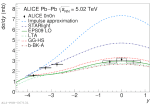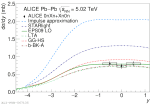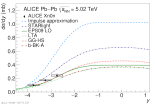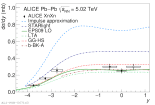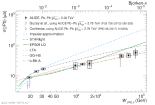Figures from paper submitted to Journal of High Energy Physics
Abstract:
The cross section for coherent photonuclear production of J/$\psi$ is presented as a function of the electromagnetic dissociation (EMD) of Pb. The measurement is performed with the ALICE detector in ultra-peripheral Pb-Pb collisions at a centre-of-mass energy per nucleon pair of $\sqrt{s_{\mathrm{NN}}}=5.02$ TeV. Cross sections are presented in five different J/$\psi$ rapidity ranges within $|y|<~4$, with the J/$\psi$ reconstructed via its dilepton decay channels. In some events the J/$\psi$ is not accompanied by EMD, while other events do produce neutrons from EMD at beam rapidities either in one or the other beam direction, or in both. The cross sections in a given rapidity range and for different configurations of neutrons from EMD allow for the extraction of the energy dependence of this process in the range $17 <~ W_{\gamma\, \mathrm{Pb, n}} <~920$ GeV, where $W_{\gamma\, \mathrm{Pb, n}}$ is the centre-of-mass energy per nucleon of the $\gamma\,\mathrm{Pb}$ system. This range corresponds to a Bjorken-$x$ interval spanning about three orders of magnitude: $ 1.1\times10^{-5}<~x<~3.3\times 10^{-2}$. In addition to the ultra-peripheral and photonuclear cross sections, the nuclear suppression factor is obtained. These measurements point to a strong depletion of the gluon distribution in Pb nuclei over a broad, previously unexplored, energy range. These results, together with previous ALICE measurements, provide unprecedented information to probe quantum chromodynamics at high energies.
JHEP 10 (2023) 119
e-Print: arXiv:2305.19060 | PDF | inSPIRE

